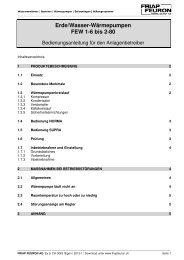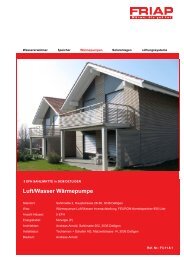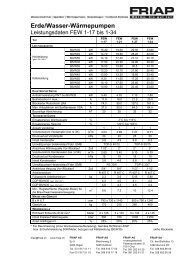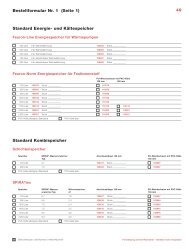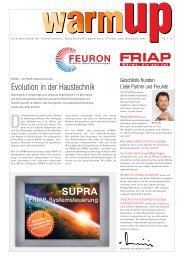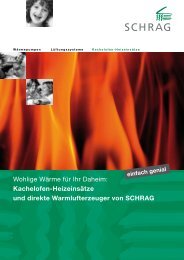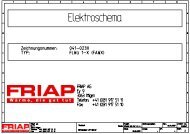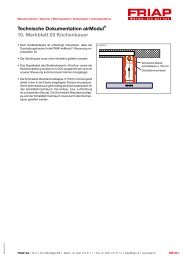BARTEC Control ETC 220 1. Einsatzgebiete 2.. Funktion 3. Montage ...
BARTEC Control ETC 220 1. Einsatzgebiete 2.. Funktion 3. Montage ...
BARTEC Control ETC 220 1. Einsatzgebiete 2.. Funktion 3. Montage ...
Erfolgreiche ePaper selbst erstellen
Machen Sie aus Ihren PDF Publikationen ein blätterbares Flipbook mit unserer einzigartigen Google optimierten e-Paper Software.
468 931 002 829-1<br />
Bedienungsanleitung<br />
Elektronischer Temperaturregler<br />
<strong>BARTEC</strong> <strong>Control</strong> <strong>ETC</strong> <strong>220</strong><br />
Achtung 1 !<br />
Das unabhängig montierte Gerät darf nur<br />
durch eine Elektrofachkraft im spannungsfreiem<br />
Zustand geöffnet werden. Anschluß<br />
gemäß Schaltbild im Regler vornehmen.<br />
Dabei sind die bestehenden Sicherheitsvorschriften<br />
des VDE und der örtlichen<br />
EVU’s zu beachten.<br />
Um Schutzklasse II zu erreichen, müssen<br />
die Richtlinien nach VDE 0100 eingehalten<br />
werden.<br />
<strong>1.</strong> <strong>Einsatzgebiete</strong><br />
Regelung von elektrischen Begleitheizungen<br />
für Frostschutzanwendungen<br />
<strong>2.</strong> <strong>Funktion</strong><br />
Ist die vom Fühler gemessene Temperatur (Istwert)<br />
unter dem eingestellten Sollwert, schaltet<br />
der Regler „EIN“ (Relais angezogen).<br />
Ist die gemessene Temperatur über dem eingestelten<br />
Sollwert, schaltet der Regler „AUS“<br />
(Relais in Ruhestellung).<br />
Hysterese<br />
Die Temperatur bei der der Regler umschaltet, ist<br />
neben dem Sollwert auch noch von der eingestellten<br />
Hysterese (Schalttemperatur-Differenz)<br />
abhängig, siehe Bild <strong>1.</strong> Sie kann über den Einsteller<br />
„Hysterese“ verändert werden.<br />
Temperaturabsenkungs:<br />
(verringerter Sollwert) wird erreicht, durch<br />
Schließen eines potentialfreien Kontaktes zwischen<br />
Klemme 10-11 z. B. über eine externe<br />
Schaltuhr.<br />
Die grüne Signalleuchte zeigt an, wenn das<br />
Relais angezogen ist.<br />
Die rote Signalleuchte zeigt einen Fühlerbruch<br />
an.<br />
Bei Fühlerbruch oder Fühlerkurzschluß<br />
schaltet der Regler (Relais) ein. Dieser Zustand<br />
bleibt erhalten, bis der Fehler beseitigt ist. (Es ist<br />
eine Variante erhältlich, die bei Fühlerbruch ausschaltet).<br />
Hysterese: Einstellen unter dem Deckel<br />
<strong>3.</strong> <strong>Montage</strong> / Installation<br />
Gehäuseunterteil über die 4 Befestigungslöcher<br />
auf geeignetem Untergrund befestigen.<br />
Kabel für Spannungsversorgung und Verbraucher<br />
über die PG-11-Verschraubungen<br />
zuführen. Kabel für s-Schaltkontakt und<br />
Sensor über die PG-16-Verschraubung zuführen.<br />
Dazu s-Kabelöffnung ausschneiden.<br />
Verschraubungen fest zudrehen, Anzugsdrehmoment<br />
25 Nm.<br />
Nicht verwendete PG-Verschraubungen mit<br />
geeignetem Material dicht verschließen.<br />
Umbau auf innenliegende Einstellung<br />
In folgenden Schritten:<br />
<strong>1.</strong> Deckel mittels 4 Schrauben lösen<br />
<strong>2.</strong> Abdeckung am Einstellknopf oben,<br />
heraushebeln. (siehe Bild 2)<br />
<strong>3.</strong> Schraube lösen und Einstellknopf abziehen.<br />
4. Achse nach innen durchdrücken<br />
5. Beiliegendes Verschlußteil von außen fest in<br />
das Loch eindrücken. (siehe Bild 3).<br />
6. Deckel wieder aufsetzen.<br />
Achtung 2 !<br />
Damit die Schutzart IP 65 erreicht wird, muß<br />
das Verschlußteil bündig mit der Gummidichtung<br />
eingedrückt sein.<br />
Bild 2<br />
Kabel für Fühler und s-Kontakt:<br />
Bei Verlegen der Kabel in Kabelkanälen oder<br />
bei längerer Parallelführung mit Netzkabeln ist<br />
eine abgeschirmte Leitung zu verwenden.<br />
Für Fühler:<br />
Verlängerbar auf max. 100 m mit Drahtquerschnitt<br />
1,5mm 2 .<br />
Für s-Kontakt:<br />
Verlängerbar auf max. 10 m mit Drahtquerschnitt<br />
1,5 mm2 . Kabeldurchmesser 8,6 mm<br />
± 0,3 mm.<br />
<strong>Montage</strong> der Fühler:<br />
Beachten Sie bei der Plazierung des Fühlers,<br />
daß ein guter Kontakt zur Wärmequelle gegeben<br />
ist. Der Fühler sollte den Temperaturänderungen<br />
im zu regelnden Medium folgen<br />
können.<br />
Fühlerkennwerte:<br />
Bild 3<br />
C Ohm C Ohm C Ohm<br />
-55 500 25 1000 110 1774<br />
-50 525 30 1039 120 1882<br />
-40 577 40 1118 125 1937<br />
-30 632 50 1202 130 1993<br />
-20 691 60 1288 140 2107<br />
-10 754 70 1379 150 2225<br />
0 820 80 1472 160 2346<br />
10 889 90 1569 170 2471<br />
20 962 100 1670 175 2535<br />
Achtung 3 !<br />
Der Schaltuhrkontakt muß potentialfrei<br />
(basisisoliert) ausgeführt sein, eine<br />
Parallelschaltung mehrerer Uhrenkontakte<br />
ist nicht zulässig.<br />
An den potentialfreien Uhrenkontakt keinesfalls<br />
Netzpotential anlegen (führt zur<br />
Zerstörung des Reglers).<br />
4. Maßzeichnung<br />
5. Anschlußschaltbild<br />
6. Technische Daten:<br />
Bestellbezeichnung: <strong>BARTEC</strong> <strong>Control</strong> <strong>ETC</strong> <strong>220</strong><br />
Best.-Nr: 10 111 002<br />
Temperaturbereich 0…60 °C<br />
Betriebsspannung: AC 230V (207…244 V)<br />
48…62 Hz<br />
Leistungsaufnahme: ≤ 4 VA<br />
Betriebstemperatur: –20°C…50°C<br />
Lagertemperatur: –40 °C…70°C<br />
Regelverfahren: zwei-Punkt<br />
Schaltkontakt: Relais – Wechsler,<br />
potentialfrei*<br />
Schaltstrom (AC 250 V) ≤ 16 A cos ϕ = 1<br />
≤ 4 A cos ϕ = 0,6<br />
Hysterese: ±0,5 ... ± 5 K (T ≤100°C)<br />
Temperaturabsenkung9 ca. 5 K fest<br />
Fühlertyp: PTC (KTY 83-110)<br />
Schutzklasse: II (siehe Achtung 1)<br />
Schutzart: IP 65<br />
Kabeleinführung: 2 x PG 11, 1 x PG16<br />
Ersazfühler 61 100 001<br />
Gewicht: ca. 440g<br />
* Auch zum Schalten von Schutzkleinspannung (SELV)<br />
Änderungen vorbehalten<br />
<strong>BARTEC</strong> GmbH · Max-Eyth-Str. 16 · 97980 Bad Mergentheim · Tel.: 0 79 31/ 5 97-0 · Fax: 0 79 31/ 5 97- 4 91 · Internet: www.bartec.de/haustechnik
Operating Instructions<br />
Electronic Temperature <strong>Control</strong>ler<br />
<strong>BARTEC</strong> <strong>Control</strong> <strong>ETC</strong> <strong>220</strong><br />
Attention 1!<br />
The separately mounted unit must not be<br />
opened except by authorised persons, and<br />
this should not be attempted unless it is<br />
isolated from the power supply. For the connections<br />
refer to the circuit diagram provided<br />
inside the cover. It is mandatory in all<br />
work on the unit to observe the current<br />
safety regulations of the VDE, or its national<br />
equivalent, and those of the local power<br />
supply companies.<br />
In order to qualify for protection class II, it is<br />
necessary to comply with the guidelines of<br />
VDE 0100, or national equivalent standards.<br />
<strong>1.</strong> Applications<br />
<strong>Control</strong> of trace heating systems for frostprotection<br />
<strong>2.</strong> Function<br />
If the temperature measured by the sensor<br />
(actual value) is below the setpoint, the controller<br />
is switched ON (relay picks up).<br />
If the temperature measured is above the setpoint,<br />
the controller is switched OFF (relay in<br />
de-energized position).<br />
Hyseresis<br />
Apart from the setpoint, the temperature at<br />
which the controller switches over depends<br />
also on the hysteresis adjusted (switching differential),<br />
see Fig. <strong>1.</strong> It can be changed by<br />
means of the adjuster “hysteresis.“<br />
Temperature setback 9:<br />
(lowered setpoint) is effected by closing a<br />
external-floating contact between terminal<br />
10-11, e.g. by means of an external<br />
timer.<br />
The green indicating lamp is lighted when<br />
the relay is in on state.<br />
The red indicating lamp warns of sensor<br />
failure.<br />
In the event of sensor failure, controller is<br />
switched ON. This state is maintained until<br />
the fault has been remedied. (Another variant<br />
is available which will be in off state if a sensor<br />
failure occurs).<br />
<strong>3.</strong> Installation / Connection<br />
Fix base of housing by means of the 4 holes<br />
provided to a suitable surface. Enter cable for<br />
power supply and load through the M 16<br />
screwed glands. Enter cable for<br />
s-switching contact and sensor through the<br />
PG-16 screwed gland. Cut out s-cable<br />
opening. Firmly tighten up screwed glands;<br />
tightening torque is 25 Nm.<br />
Tightly seal unused screwed glands using<br />
suitable material.<br />
Modifikation for internal temperature setting<br />
Proceed as follows:<br />
<strong>1.</strong> Remove cover by taking out 4 screws<br />
<strong>2.</strong> Lever out cap at top of adjusting knob.<br />
See Fig 2<br />
<strong>3.</strong> Slacken screw and pull off adjusting knob<br />
4. Push spindle down into the interior<br />
5. Firmly press the closure plug supplied into<br />
the hole from the outside (see Fig. 3)<br />
6. Re-place cover.<br />
Attention 2!<br />
In order to qualify for degree of protection<br />
class IP 65, it is necessary that the<br />
closure plug should be pressed in solidly<br />
with the rubber gasket.<br />
Fig. 2<br />
Cable for sensor and s-contact:<br />
Use screened cables where leads are installed<br />
in cable ducts or where they are run in parallel<br />
with power cables for some distance.<br />
For sensors:<br />
May be extended to a maximum of 100 m<br />
with <strong>1.</strong>5 mm 2 conductor area.<br />
For s-contact:<br />
May be extended to a maximum of 10 m with<br />
<strong>1.</strong>5 mm 2 conductor area.<br />
Cable diameter: 8.6 mm ±0.3 mm.<br />
Installation of sensors:<br />
When installing the sensor, make sure that<br />
satisfactory contact exists with the heat<br />
source. The sensor should be able to follow<br />
the temperature changes in the medium to be<br />
controlled.<br />
Sensor characteristics:<br />
C Ohm C Ohm C Ohm<br />
-55 500 25 1000 110 1774<br />
-50 525 30 1039 120 1882<br />
-40 577 40 1118 125 1937<br />
-30 632 50 1202 130 1993<br />
-20 691 60 1288 140 2107<br />
-10 754 70 1379 150 2225<br />
0 820 80 1472 160 2346<br />
10 889 90 1569 170 2471<br />
20 962 100 1670 175 2535<br />
Attention 3!<br />
The timer contact must be floating (basic<br />
insulation); parallel connection of several<br />
timer contacts is not permissible.<br />
Never apply mains voltage to a floating<br />
timer contact (this will cause destruction of<br />
the controller).<br />
4. Drawing<br />
5. Wiring diagram<br />
6. Technical data:<br />
Order No. <strong>BARTEC</strong> <strong>Control</strong> <strong>ETC</strong> <strong>220</strong><br />
EDP No.: 10 111 002<br />
Temperature range: 0…60°C<br />
Operating voltage: 230 V AC (207…244 V)<br />
48 …62 Hz<br />
Power consumption: ≤4 VA<br />
Operating temperature: –20°C…40°C<br />
Storage temperature: –40°C…70°C<br />
<strong>Control</strong>ler type: ON/OFF<br />
Switching contact: Relay 1 x c/o contact, floating*<br />
Switching current: ≤16 A cos ϕ = 1<br />
(250 VAC): ≤ 4 A cos ϕ = 0.6<br />
Hysteresis: ±0.5…± 5K (T ≤100°C)<br />
Temperature setbacks: Approx. 5 K fixed<br />
Type of sensor: PTC (KTY 83-110)<br />
Protection class: II (see Attention 1)<br />
Degree of protection: IP 65<br />
Cable entry: Screwed glands: 2 x M 16; 1 x PG 16<br />
Sensor as replacement 61 100 001<br />
Weight: Approx. 440 g<br />
*Also for switching safety extra-low voltage (SELV)<br />
Specification subject to change without prior notice<br />
<strong>BARTEC</strong> GmbH · Max-Eyth-Str. 16 · 97980 Bad Mergentheim · Tel.: 0 79 31/ 5 97-0 · Fax: 0 79 31/ 5 97- 4 91 · Internet: www.bartec.de/haustechnik<br />
Fig. 3



